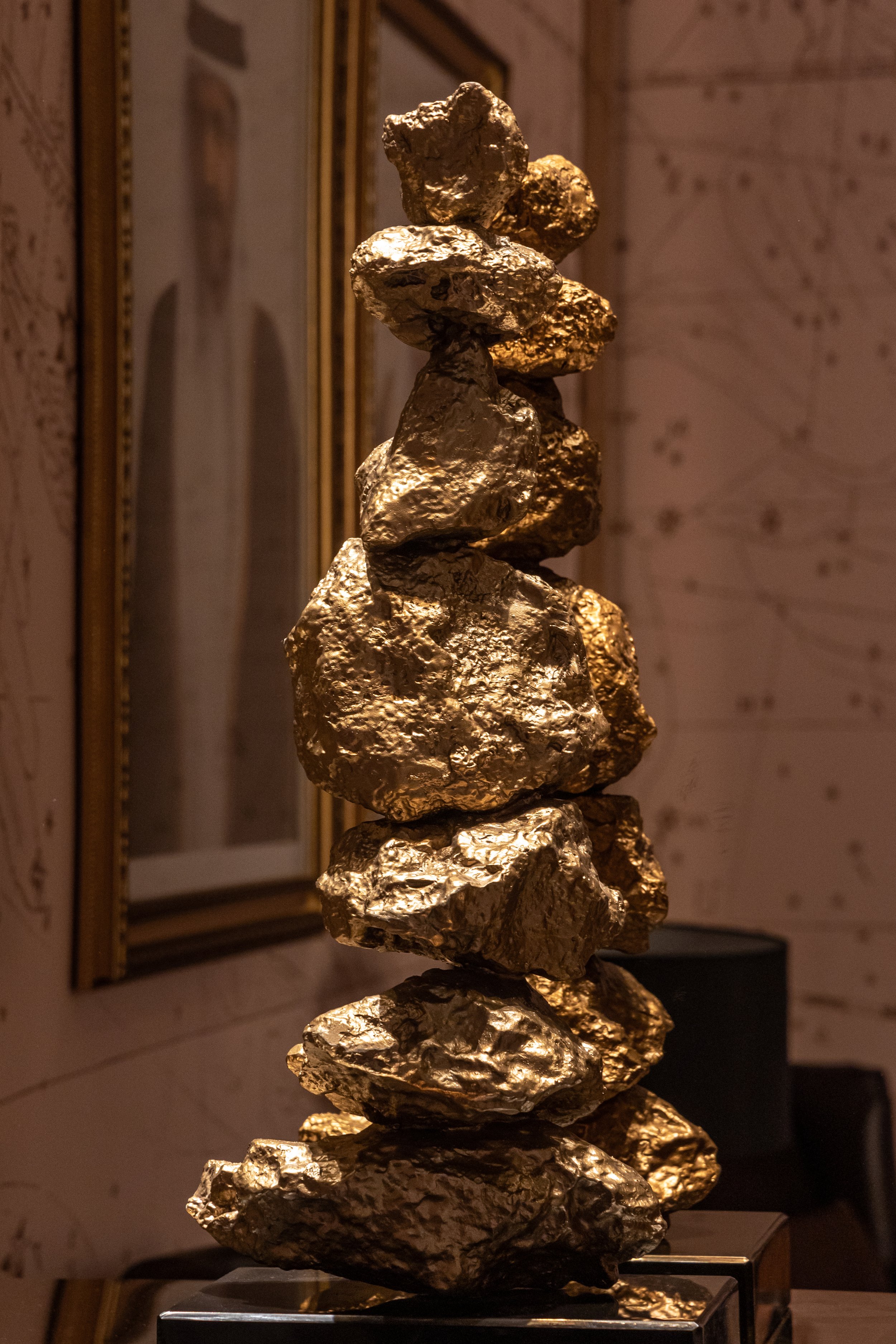Katara Towers Lusail
Trading Cultures
For centuries the Qatari people have distinguished themselves as traders of culture. With an unwavering confidence and remarkable adaptability, they have embraced the infusion of elements of diverse cultures into their own art and craft, and have had the pride to export it outwards and invite in more. Trading cultures has become the gold thread with which we weaved the story of the art collection for the Katara Towers complex, which hosts both the Raffles and Fairmont Doha.
As a point of inspiration for the art collection, ArtLink conceptually deconstructed a Qatari rock into its basic elements of sand, stone, glass and iron ore, using these materials as a guide for our curatorial journey with dozens of artists involved in bringing the collection to life.

Raffles Doha
Polished Splendour
Upon entering the Raffles Doha one can immediately notice the elegance, refinement, and fine finishes of every material around. Glamour and splendour have always been part of Qatar’s culture, as it is known for having the best welders and polishers. Archaeological findings in Qatar’s land include various metal objects with state-of-the-art finish and marvellous products made with great attention to detail.
The art collection alludes to richness and brilliance of Qatar with exquisite pieces; each a fine jewel, waiting to be discovered.

The Writer’s Bar
The library in the Blue Cigar Lounge is the pulsating cultural heart of the project, a pediment to the celebration of the exchange of cultures. It is curated to create a unique guest experience; surrounded by books, the bar invites conversation, shared experiences, and the indulgence of a wealth of knowledge of diverse existing cultures.
Thousands of the world’s classic literary works are available for guests to read or simply browse while indulging in food or drinks inspired by the stories in the books surrounding them. Through this unique bar, the strong element of shared community that made Qatari people ‘Traders of Cultures’ is celebrated.
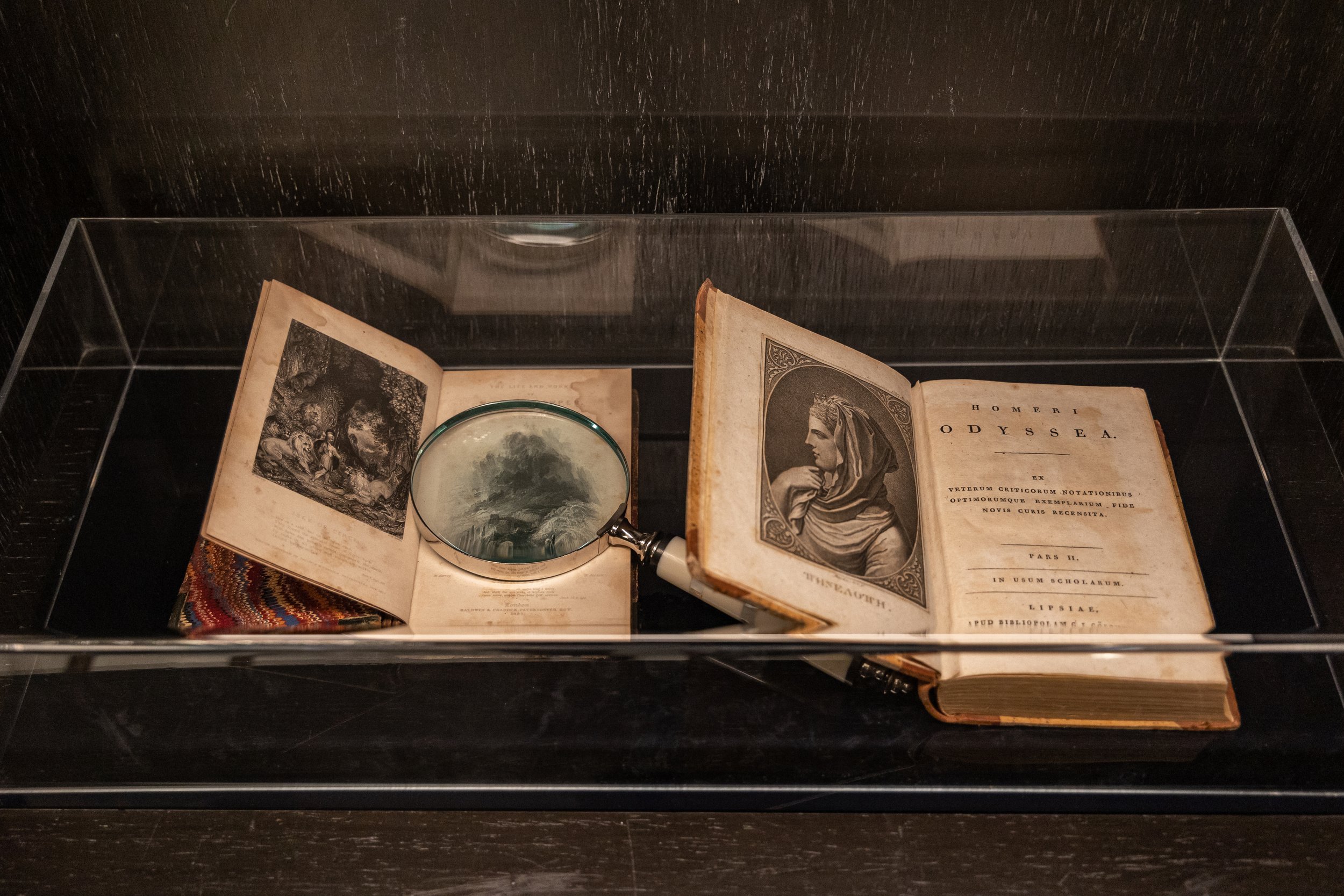

Elevated Craft
Upon entering the Lusail Tower's main atrium lobby, guests are met with an added layer of sophistication and shine. The artworks in the lobby reference the development of local craftsmanship skills that have advanced over the years, as skillful stone carving techniques have been translated into refined metalworking practices.
A mesmerizing focal point, this larger-than-life geometric sculpture by HYBYCOZO Studio exudes luxury in the. Paying homage to the element of metal, it is made of stainless steel coated in gold powder. The laser cut patterns draw on inspirations from science, mathematics, and natural phenomena.
The Breath of the Starry Night
The oil works on sandpaper depict the meditative moment during sunset and sunrise on the dunes. Using the sand as a medium of art, artist Matteo Montani celebrates the local culture and refers back to its landscapes, revealing them through a new dimension.
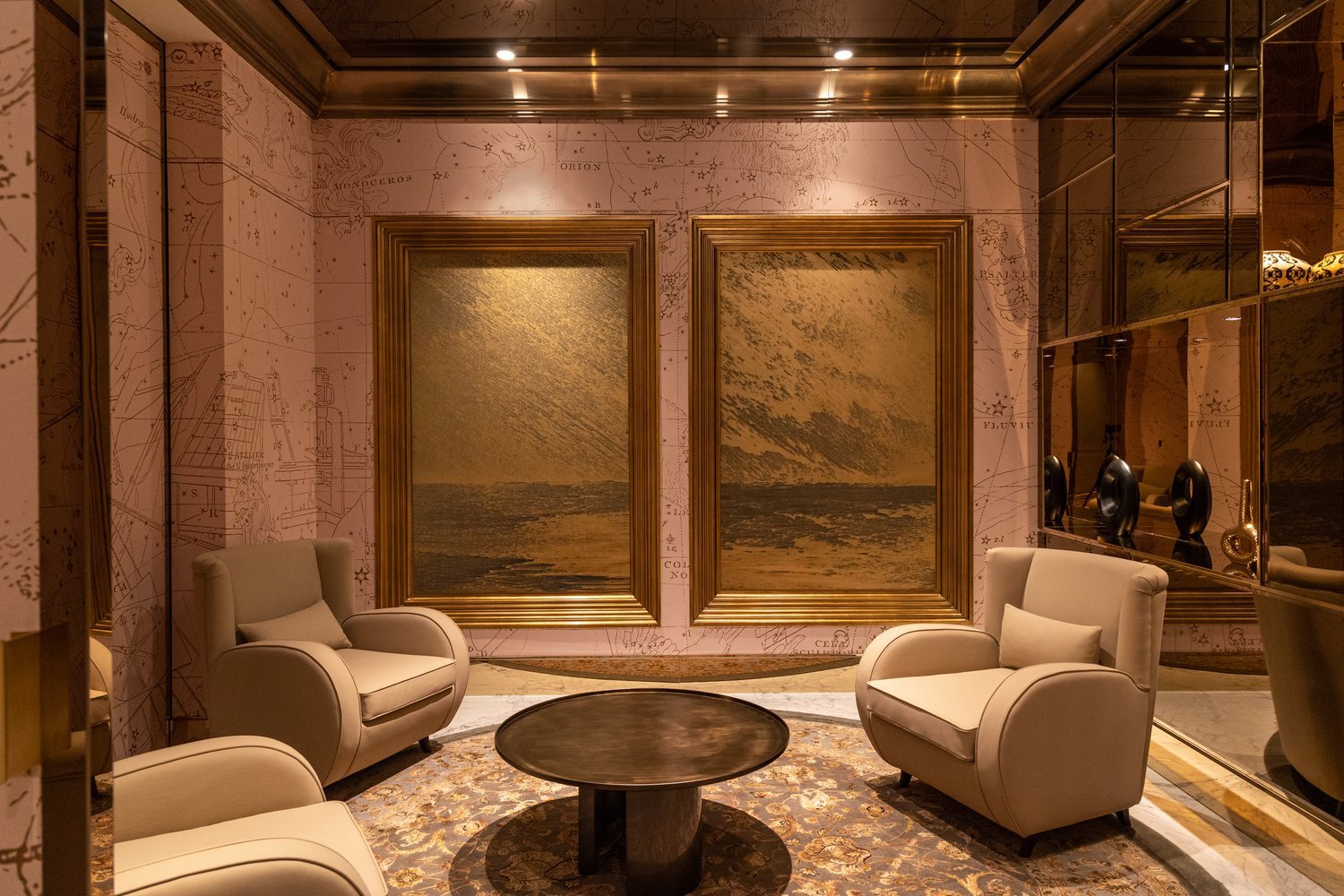
Vertical Landscapes
Excavated during the 20th century, rich archeological findings trace the Qatari strive for finesse and excellence as far back as to the 4th century BC. Among the variety of discoveries, two material families – stone and metal – tell the story of a nation through the refined craftsmanship of gifted stonemasons, goldsmiths, and jewelers. Elaborate rock carvings, bejeweled rings, and polished blades are a few examples of the qualities that have made the early Qatari artisans stand out.
Marking Katara Hospitality’s 50th anniversary, the art collection for the two Katara Towers is curated to revive the sense of awe one feels in the presence of excellence and to reinstate that long-standing commitment to excellence Qatar holds for prosperity. Viewing this work from the side, the work refers to the the developing skyline of Lusail as a young and fast-growing city. Viewing it from above, the shapes of the structures create geometric patterns that allude to traditional Islamic aesthetics. In this way, Qatari artist Noor Abuissa ties the past and the present together into one simultaneous representation.


El Rein
The concierge art collection includes a unique sculpture, standing out in a landscape of beauty. The sculpture refers to the cairns, stacked stones that the Qatari people used as signs directing themselves and others to different locations. Using natural materials in conversation with culture and present-day experiences, artist Shua’a Ali reinterprets in a contemporary way a traditional element symbolizing home.
The Making of Royalty
Qatar’s geographical location has placed the country at a crossroads of both maritime and overland trading routes, bringing a wide range of commodities to the country. This has influenced the local production of a wide variety of craft objects to the highest design and craftsmanship levels, continuously striving to excel. The works at the important Amiri Lounge are inspired by the creation of jewels. The two glass artists featured in this installation, James Lethbridge and Hanne Enemark took inspiration from the exceptional works in the Al Thani collection in Paris that was assembled by the family of the Emir of Qatar, telling a story of a developing artistic excellence.
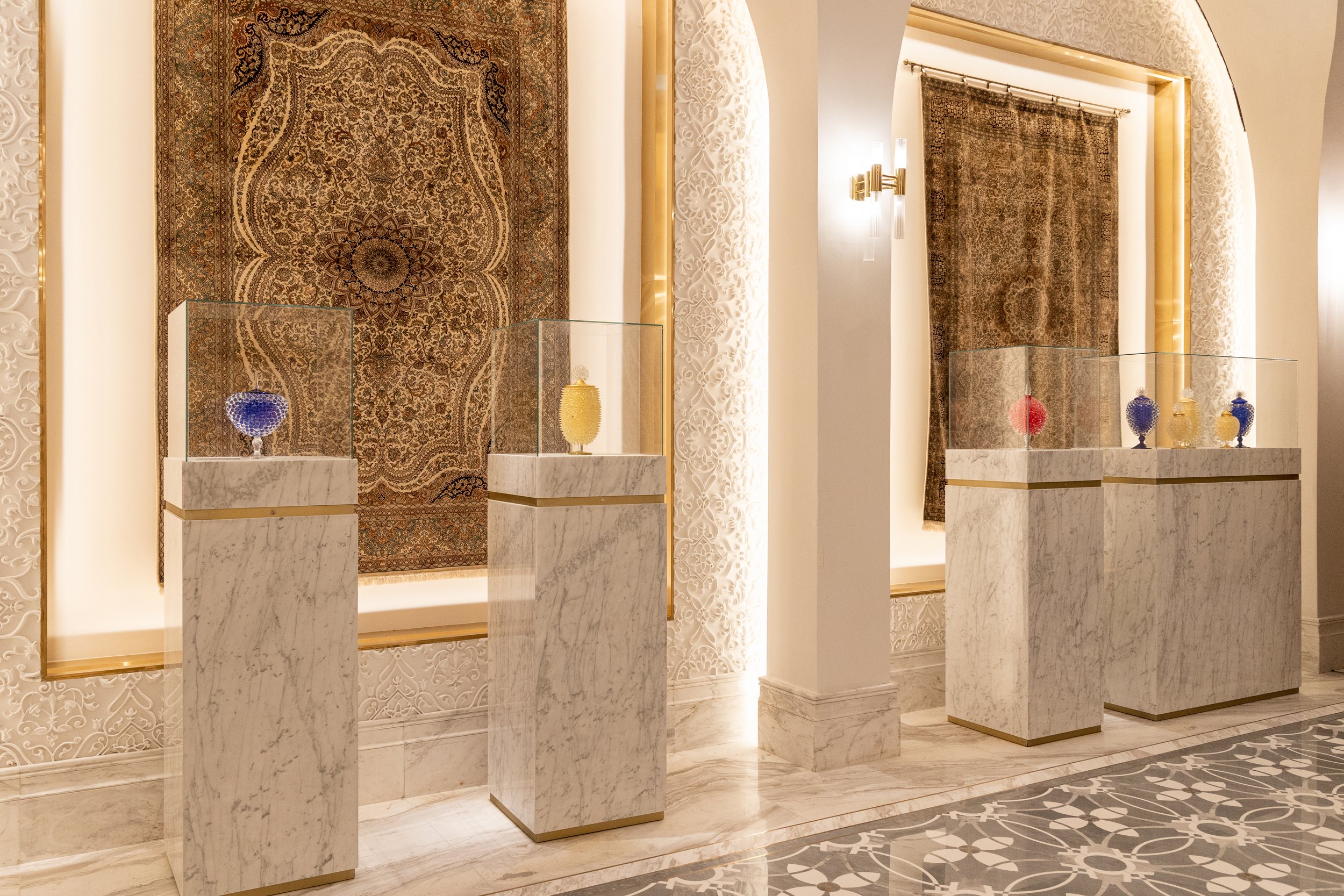

James Lethbridge


Hanne Enemark


Fairmont Doha
Elevated Land
The land of Qatar reveals a rich history and uncovers the secrets of a mighty country, with findings of treasures of thousands of years ago. The Fairmont Doha’s art & craft collection embodies the memories engraved in Qatar’s soil. It recounts the exploits of the saviours and swordsmen who once lived on this land and the far sighting visions of its present-day entrepreneurs. The prints carved into its stones are reminders of a culture of progress and beauty. Inspired by geological surveys, the collection of artworks showcases an array of different textures, unveiling layers of materials to inspire the guests’ sense of curiosity and urge for exploration, while celebrating the richness of materials found in nature.


Through the Smoke
The wall of teapots at the tea lounge is dedicated to the culture of Qatari hospitality. Embedded in the aesthetics of ancient ceramics, the artist attempts to capture the transience of life, and the power of tradition, through replication and rearrangement. Master artisan Kati Jünger worked side by side with her village to produce these 64 teapots, creating a community as a replica of the congregation of the Qatari people during winters, coming from the seaside to the land and gathering to have tea and tell stories.
The arts of infusion and ceramics come together in this display, complemented by an adjacent piece highlighting the aromatic qualities of infusion and perfumery.
A transparent and fragrant trail travels the room, leaving behind a sense of tranquillity and comfort. This large-scale installation, made of crystal and precious metals is inspired by the converging shapes of water droplets rising in the air, leaving behind a curved golden fragrant trail. A combination of transparent crystal ripples converges seamlessly with their narrative gold counterparts creating a flowing sculptural installation with a strong connection to nature.
Made by the famed London-based design firm Haberdashery, the piece alludes to the art of perfumery and infusion, with medicinal herbs, essential oils, teas, potions and remedies taken from the surrounding natural setting. The wall piece highlights the enhanced aromatic effects of the infusion process.


The Perpetual Motion of a Dune
A spectacular installation by Giles Miller welcomes guests into the ballroom, celebrating the perpetual motion of a dune. Using material and light, a sea of ‘pixels,’ in different textures of gold, follows the aesthetics of desert winds moving through sand. The result is a detailed composition of meticulously arranged components that created a sense of richness, tactility, depth and allure. This piece acts as an intriguing point of focus and traces the different perceptions of the dune.

Curved Winds
How can we perceive the immensity of a desert dune?
Believing that the key to perceiving a whole element is to share each perception, artist Natalie Blake divided an aerial image of a dune into different wall tiles, all distributed throughout the hotel’s guest rooms. Each room showcases a piece of the movement of wind captured in clay, allowing the dune to only be fully seen by an entire community as a whole, through the shared views of each guest.
This work takes inspiration from the constant formation of sand dunes by Qatari winds. Crafted individually by hand, the textured tiles represent the desert movement and the subtle smooth dune-like surfaces.



Natalie Blake Studios
Fire & Ice
The glass installation for the Fire & Ice Restaurant (now renamed to 'Provok') was crafted in collaboration by master glass artisans Louis Thomson and Hanne Enemark. The two mirroring walls embody the metamorphosis of glass inspired by the design of the two restaurants, moving from the cold icy breeze to the hot flames of fire used in the crafting process. Two mirroring walls embody the metamorphosis of glass inspired by the design of the two restaurants, moving from the cold icy breeze to the hot flames of fire used in the crafting process. Depending on the sun's position and intensity, the effect of the natural light through the glass pieces produces ever-changing tones of oranges such as ambers, ochre, and bronze, and blues such as aquamarine, violet and azure, culminating in two different, but visually rich experiences within one space.


The collection interplays each unique object through colours, form, or material quality, while referring to Qatari history. These 108 glass objects are made from solid glass but give the illusion of a container, containing local specimens of desert sand suspended in a richly coloured medium. The sand patterns are inspired by the of dunes the desert, and the movement of the sand. Others reference the Qatari element of metal, with gold and platinum fibres displayed inside. The forms are not solely aesthetic – each is a nod to different shapes and elements found in Qatari culture and history.
The number 108 refers to spiritual completion. Fashioned after the idea of a “work in progress,” various series of of the glassworks are displayed showcasing the process, with the first item in the sequence as the form in its original state and the subsequent items progressing to the final finished state.
The shapes are not random – each a nod to different forms found in Qatari culture.


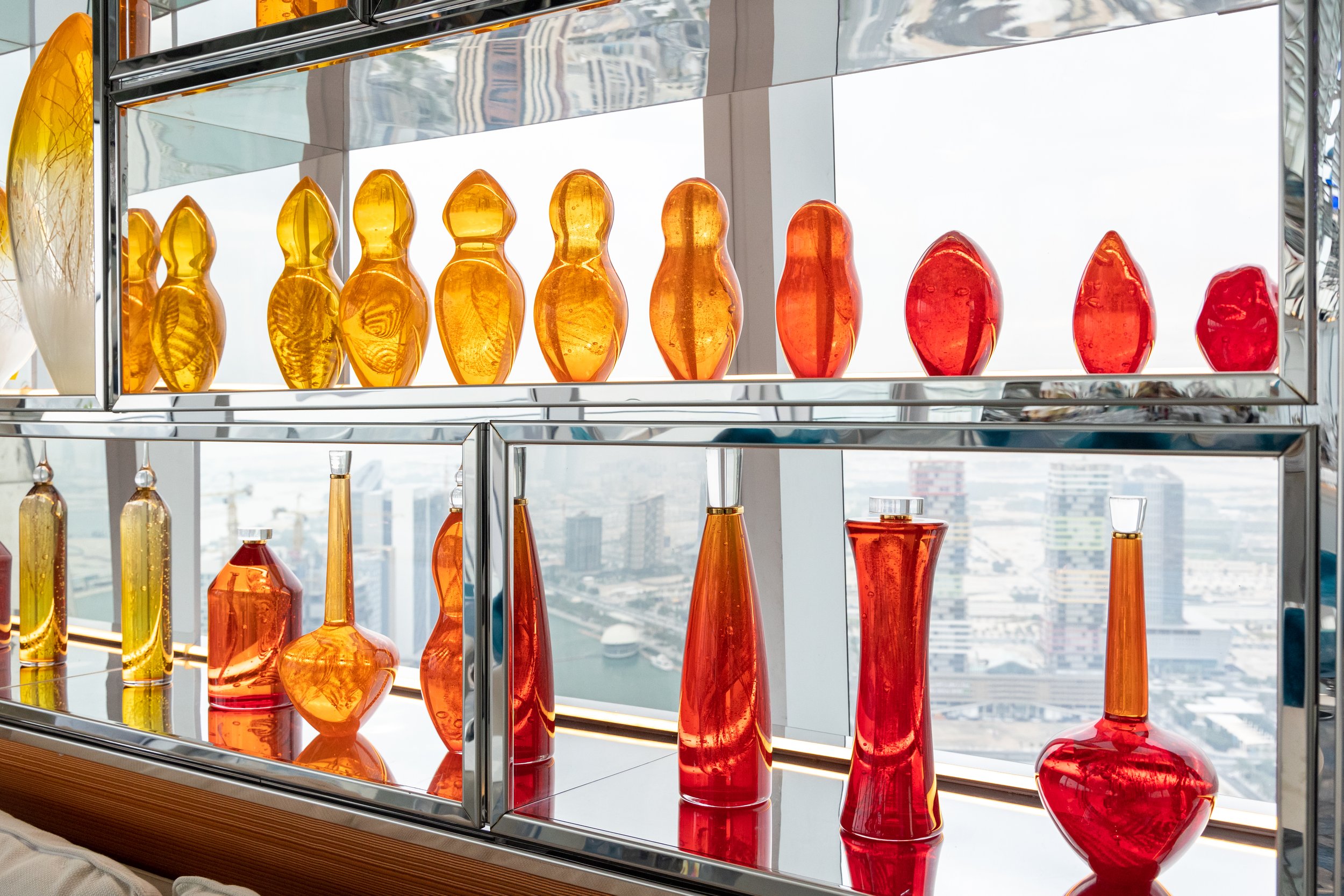
Layers of the Earth
Different layers of materials raise one’s curiosity and call for exploration. Tranquillity is conveyed via natural material, inviting all to linger in its depths. Similarly, the art collection keeps entertaining the eye, with coloured marble and crystallized stone works revealing the layers of the earth. Artist Edward Locota depicted the geological structure of the Qatari land and reinterpreted it. The six sculptures in marble, glass, resin and rocks depict the rich soil of the land.

Layers of Sublime
The series by Jesús Perea in the circulation corridors starts on the first floors with a more literal identification with Qatar and other cities of the world, becoming more abstract as one goes up: From the first to the 13th floor, the pieces feature different places worldwide where Katara has landmark projects. Using maps from these locations as a canvas, the artist then applied his signature abstract designs alluding to the specificities of the site, the contours of the buildings, their design and spirit. From the 14th floor to the top, the works are inspired by the views from the Katara Towers in Lusail and to the relation of the building to its surroundings – in land, water and sky. The combination of cartography and abstraction brings in the viewer to both enjoy the image and appreciate the site. Each floor is coded with a different tonality, moving from warm colors at the first 10 floors, cooler colors at the next 10 floors, and monochromatic works at the top floors. Overall, 109 unique works spread over 29 floors.
“The use of maps of both Qatar and other locations proposes a double reading: the representation of the map itself, whose identification requires careful observation from the viewer, and the integration of the map within the artwork as a texture, as a graphism, as an element that is part of a composition, giving it life and dynamism.” These subtle and sensual cartographies invite the viewer to an attentive closer look. Along with architecture - traditional and contemporary - as well as the striking power of the Qatari landscape with its palettes, colors and textures, highlights arches and sand, splashed of water, and the darkness of the desert night, which all transform our perception. “Each piece, a sort of monolith, is a new architecture that dialogues with the rest of the artworks, both on each floor and in the rest of the building. They are all parts of a whole.” – Jesús Perea




Works Provided
Client: Katara Hospitality
Works Provided: 3,463
Artists: 43
Scope: Public, Guest & Landscape Areas
Services Provided
Research
Development of Art Concept
Art Selection & Curation
Artist Relations Management
Commissioned Artworks Management
Custom Prints
Custom Framing
International Shipping and Delivery
Installation
Collection Cataloging


